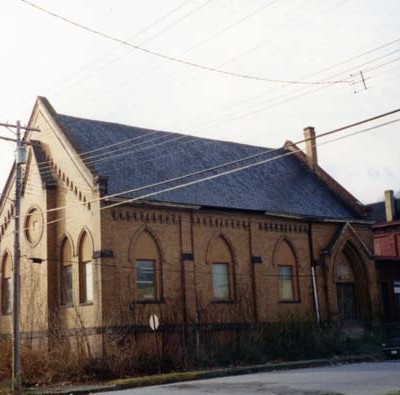
The high plateau above the Beaver River, north of the Ohio River, was settled in the late 18th century. The town was called Brighton and later renamed Beaver Falls. The Harmony Society led an economic revival in the area in the mid-19th century. Beaver Falls was incorporated as a borough in 1869 and a city in 1928.
The first Jewish settler in Beaver Falls, Pa. was Charles Levi, a twenty-four-year-old baker who arrived in 1870. Max Solomon opened a scrapyard in Beaver Falls in the 1880s. At the time that these men and their families, and other families like them, were settling in Beaver Falls, the Jewish community of Beaver County was centered at a moderately Reform congregation in nearby New Brighton called Tree of Life. Some of the early Jewish families in Beaver Falls were likely Reform as well. In December 1871, twelve Jewish families from the Beaver Valley arranged for Rabbi Judah Wechsler of Columbus, Ohio, to come to New Brighton. His address at a local church drew a Jewish and non-Jewish audience, according to The Jewish Experience in Western Pennsylvania, A History: 1755-1945.
Tree of Life gradually dissolved after its leading member died in 1883. Over the next two decades, Beaver Falls became the larger of the two neighboring Jewish communities. A group of mostly Lithuanian immigrants chartered Agudath Achim Congregation of Beaver Falls on October 20, 1904, with nine members, Asher Hanauer, Max Solomon, Morris Gordon, William Pfeifky, Moses Solomon, Louis Wasbutzsky, Nathan Rosenberg, Simon Berkman and Louis Wilkofsky. That same year, a group of women associated with the congregation founded the Agudath Achim Sisterhood. Agudath Achim established a cemetery in White and Patterson Townships in 1906. Agudath Achim initially met at the Hanaur Theatre Building at the corner of 7th Avenue and 5th Street in Beaver Falls, according to a Works Progress Administration Church Archives survey. The Orthodox congregation built its first synagogue at 6th Avenue and 5th Street in 1914.
By the early 1920s, Beaver Falls and New Brighton essentially comprised a single Jewish community, which often referred to itself as the Beaver Valley. The Beaver Valley Section of the National Council of Jewish Women was founded in June 1917 with Nettie Silverman as its first president. Among the first projects of the organization was establishing the Beaver Valley Hebrew Religious School, which held its first confirmation ceremony in 1917.
The B’nai B’rith Lodge No. 777 was founded on June 12, 1921 with 35 members. The lodge met at rented rooms until 1947, when it purchased meeting space on 16th St. The lodge eventually oversaw several youth organizations in Beaver Falls, including the Beaver Valley A.Z.A. No. 117 in 1929 and the Beaver Valley B.B.G. in 1941. The Beaver Valley Zionist District was founded around the time of Agudath Achim Congregation, and perhaps earlier. It later became a chapter of the Zionist Organization of America. The Beaver Valley Chapter of Hadassah was founded on March 18, 1945. In 1947, a group of Agudath Achim members who had recently returned from military service in World War II formed a Men’s Club at the congregation. The group served a spiritual and educational mission, meeting after morning prayers for monthly study and conversation.
The Jewish population of Beaver Falls and New Brighton grew steady over the first half of the 20th century. A directory in the 1907-1908 edition of the American Jewish Yearbook listed 45 members associated with Agudath Achim. The yearbook listed a Jewish population of 121 for Beaver Falls in its 1918 edition, 300 for Beaver Falls and 95 for New Brighton in its 1928-1929 edition, 415 for Beaver Falls and 250 for New Brighton in its 1940-1941 edition and 813 for the combined “Beaver Valley” region in its 1951 edition.
The growth in population created communal opportunities. A new Reform congregation called Beth El was established as early as 1948. In early 1955, a Beaver Falls resident named Jacob Venger called a meeting for the purposes of creating a Jewish community center in Beaver Valley. The group acquired property in Chippewa Township in January 1957 and officially chartered the Beaver Valley United Jewish Community that December. The new Beaver Valley United Jewish Community Center was dedicated in May 1960. In addition to having meeting halls and classrooms, the new center was designed with two sanctuaries. Agudath Achim Congregation moved into the main sanctuary. Beth El decided not to affiliate with the center and later dissolved, but a second Reform congregation called Beth Sholom was created in 1960 and used the smaller sanctuary. The Beaver Valley United Jewish Community Center also became a centralized meeting place for Jews living outside of the Beaver Valley. After Tree of Life Congregation in nearby Rochester closed in 1973, many former members came to Beaver Falls.
The Jewish population of Beaver Valley began to contract in the 1980s. The American Jewish Yearbook listed a population of 350 for Beaver Falls and 500 for “Upper Beaver” in its 1984 edition and a population of 200 for “Upper Beaver County” in its 1992 edition. Beth Sholom disbanded in 1986. The three Jewish women’s organizations in the area were holding combined meetings as early as 1997. The Beaver Valley United Jewish Community Center merged with Beth Samuel Congregation in Ambridge in 2006.